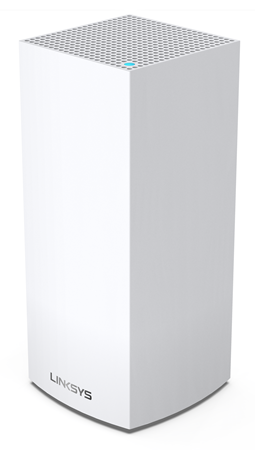
The Linksys SPNMX42K9-UK supports the latest Wi-Fi® 6 (802.11ax) standard to deliver next-level streaming and gaming. It offers faster WiFi performance for lag-free online gaming and simultaneous streaming to any device.
This router is for Kloud9 subscribers in the United Kingdom.
HARDWARE INFORMATION
It has four ethernet ports:
- One gigabit internet (WAN) port
- Three gigabit ethernet (LAN) ports
SETUP AND INSTALLATION
Kloud9 installers will provide a first-time installation. However, if you have reset your node, you can set it up through the Auto Configuration Server (ACS) setup process.
You will need the following:
- An active Kloud9 internet connection
- The Linksys SPNMX42K9-UK
- The latest version of the Linksys app
- iOS or Android™ mobile device
- Linksys cloud account for remote management
You can add a node through the Linksys app on your Android or iOS device. Keep in mind that a node that is not from Kloud9 may be added to your network (so long as it will be set up as a child node and not as the parent node), but it may not benefit from the features that Kloud9 offers. Contact Kloud9 first.
The WiFi name and password are printed on the router's product label. The default WiFi name is Kloud9-followed by the last four alphanumeric characters of the router’s MAC address. For example, Kloud9-xxxx. Each router has a unique pre-assigned WiFi password.
The guest WiFi name is similar to the main WiFi name, but with a -guest appended to it. For example, Kloud9xxxx-guest.
To configure the Guest Network/Guest Access feature on the Linksys app, go to the menu, tap on Guest Network on your Android device or Guest Access on iOS, toggle the switch to enter your settings, then tap Save.
The router has two default passwords depending on its configuration state:
- Unconfigured: admin
- Configured and online: default WiFi password located on the product label
If you log in locally, the default admin password is the default WiFi password located on the product label. If you have already changed the admin password, just use your customized admin password and click on Sign In. You can also log in to the router's web browser using your Linksys cloud account credentials.
Yes, it supports WPS pairing using the button on the device and within the Linksys app or the LinksysSmartWiFi.com page.
The Linksys SPNMX42K9-UK supports Automatic Setup, meaning that once the node is plugged into Kloud9’s equipment, and it detects an internet connection, the node will automatically set itself up as a parent node. The light will start to flash white. Once it has configured itself as a parent, the light will turn solid blue.
SECURITY AND PRIVACY
The router supports the following settings:
- WPA2™/WPA3™ Mixed Personal
- WPA3 Personal Only
- WPA2 Personal
- Open and Enhanced Open
- Open
While the Apple® HomeKit integration feature is not supported, your HomeKit-enabled devices will still function normally as they are treated as regular clients on your network.
To learn how to configure Parental Controls, click on the links below:
ADVANCED TROUBLESHOOTING
The router will automatically update whenever new firmware is available.
The Linksys SPNMX42K9-UK doesn't support retail firmware or manual firmware updates. The node will only allow automatic firmware updates directly from Kloud9.
- Log in to the Linksys app, tap the menu icon, and go to Network Administration, select a node from the list, and look for Firmware Version.
- Log in to the LinksysSmartWiFi.com page. Go to Router Settings > Connectivity > Basic. Click the drop-down arrow next to Details in the Firmware Update section and look for Current Version.
The External Storage feature allows you to connect an external storage device to the router's USB port and allows access to the hard drive.
The Linksys SPNMX42K9-UK supports these file formats:
- Windows®: NTFS and FAT32
- Mac®: FAT32 and HFS+ (journaled, non-journaled)
To reset the router, press and hold the reset button until the light on the top turns red, fades, and then flashes bright red.
Make sure that the light will show a bright red flash, followed by three to four quick faded red pulses, and another bright red flash before you release the button.




